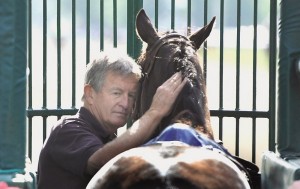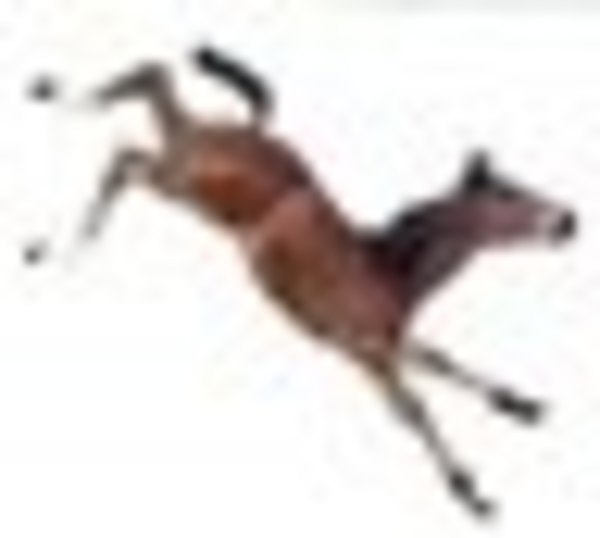
Horse trainer Bob Duncan takes horses back to school to get over their gate fears, and starts two-year-olds in a relatively fear-free environment each summer at Saratoga. Read about his work in a recent feature article in the Albany Times-Unionwith a series of great photos by Skip Dickstein.
This is a story about something called natural horsemanship. It’s something I’ve never understood when it is written as Natural Horsemanship and has a price tag attached to it, or a copyright symbol, for that matter.
The natural horsemanship industry is a complicated field, one that started with a couple of iconic horse trainers sharing their methods for breaking horses. It is one that has evolved into a vast network of specialists with different approaches to the horse-human interaction. Each specialist seems to have a set of devotees and critics.
But natural horse training isn’t just about starting young horses. It is much more often about restarting horses. Or bringing together horses and their humans. Or bringing them back together.
So how heartwarming was it this winter when one of the most promising three-year-old racehorses in the country was turned over to a natural horsemanship devotee for some remedial training? Quality Road had a frightful experience when loading into the starting gate for the 2009 Breeders Cup Classic at Santa Anita in November.
Quality Road was so traumatized by his experience that he refused to get on the airplane for his flight back to New York. He had to be vanned home. His trainer, Todd Pletcher, knew what a great racehorse he had, and he knew that he needed help. He went to Bob Duncan, the former starter for the New York Racing Association, who works as a consultant at Saratoga and trains the young horses to load into the gate. Bob applies what he calls a form of natural horsemanship to help the horses get over their fear and accept the gate. He’s become somewhat famous for his approach, although most people can’t understand why all starting gate training wouldn’t follow his principles. Others wonder what all the fuss is about.
By January, Quality Road was completely nonchalent about the gate again, and accepted it as a routine part of his training. Right after this video was made, he went back to racing and he has won all three of his starts. He’s the heavy favorite for two big stakes, the Whitney and the Woodward, at Saratoga in August, thanks to the benefits of someone who knows how to apply natural horsemanship.
At the Grayson Jockey Club Foundation Welfare and Safety of the Racehorse Summit last month in Lexington, Kentucky, Duncan drew the only round of spontaneous applause from the audience when he suggested that natural horsemanship training should be higher up the list of priorities for racing than the development of safety equipment.
“The best safety vest in the world won’t help if a horse is upside down in the gate,” he said. He said that riders need to develop better horsemanship to give horses more confidence and suggested that grooms and hot walkers, who spend the most time with the horses, know very little about equine behavior and could benefit from simple skills in natural horsemanship so they can help the horses who have issues like fear and panic and aggression.
Natural horsemanship doesn’t always please everyone. Just like classical vs modern dressage, natural horsemanship is open to interpretation. And if you step outside the line, the critics will notice. If it’s not “natural” in the eyes of the observer, is it abuse?
That is the scenario that unfolded earlier this month in England, when a demonstration by Pat Parelli with Catwalk, a jumping stallion owned by Robert Whitaker, went awry. Pat had trouble handling the horse’s head. This clip shows a typical scene; we’re told that three-legged treatments went on for a long time. The horse was distraught and fought being touched, the trainer was persistent, his microphone fell in the dirt. The audience was left in the dark but they didn’t like what they saw. They fell silent.
Pat Parelli posted this video of his second day of work with Catwalk; the horse is obviously relaxed and not intimidated by him. The public, however, was incensed by the first day. No less than 165 pages of discussion erupted on the Horse and Hound online forum. The inevitable Facebook hate page appeared.
Pat Parelli apologized in this video letter, but the damage was done. Once again, we have the Internet judging someone, just as we have had with Blue Tongue Dressage, Michael Morrissey’s whip, and Amy Tryon and Le Samurai.
My take on the two stallions and the two trainers comes down to why there were no 165 pages of complaints and anger when Quality Road was treated that way at Santa Anita–and that was shown on national television. There was some protest, but nothing like on the level of what has been hurled at Parelli or Morrissey or Patrick Kittel.
Quality Road and the other horses and riders and starter’s assistants could have been hurt very badly. Luckily for the stallion, there was a Bob Duncan to help him afterwards, but that starting gate rodeo could have had a tragic ending. Could it have been prevented? There are those who say it could have been. If the horse was mishandled before he went into the gate, you have to give credit to the fellow who clung to his bridle when he came flying out. He may have saved the horse’s life, by risking his own.
It seems like the horse world is moving to a double standard. In some arenas, horsemanship is scrutinized under a microscope–shoes are cruel, bits are bad, the footing at Show X is dangerous, please refer to whips as crops. While in other arenas, no one is paying much attention and the show must go on.
Is the online horse world becoming more concerned with tribal ideology and less in touch with real live horses themselves? Who are these anonymous online critics who claim such authority? We’ll never know, nor will their targets.
One thing is for certain: tribal condemnation is a “natural” human instinct that the Internet seems destined to nurture.
by Fran Jurga | 15 July 2010 | The Jurga Report at Equisearch.com Follow @FranJurga on Twitter.com for more horse health news!









